2020 has been a particularly busy year even with the Covid-19 pandemic causing restrictions across everything that is being achieved. Portsmouth Water though have progressed 4 pilot trials and started a new one and convened an on farm workshop providing farmers with updates of the trials. Below is a summary of these and look forward to 2021.
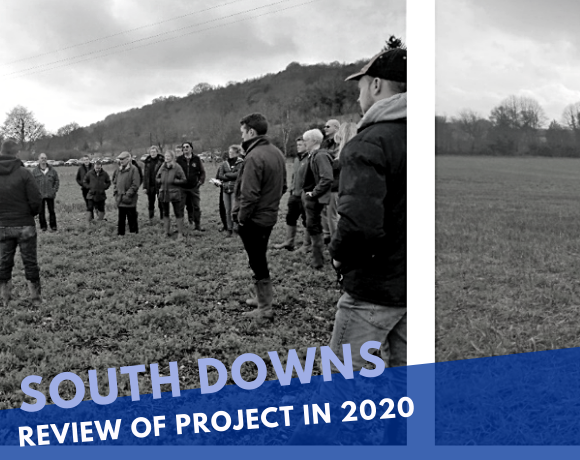
Farmer events
On the 3rd February 2020 Portsmouth Water held an event for local farmers and other interested stakeholders to come visit and discuss their cover crop trials being delivered through the CPES Interreg Project South Downs Groundwater Case Study pilot.
The event started with a site visit to one of the cover crop trial sites, with Stephen Woodley (agronomist and soil specialist) and Simon Deacon (Portsmouth Water) presenting the results of the soil and water testing carried out to evaluate nitrate leaching levels. This was followed by Susie Holmes (Soil Specialist) presenting the findings of another cover crop trial from a different farm as part of the CPES project. Though cold outside, the farmers had plenty of questions and shared their own experiences of cover cropping which proved to highlight the need to organise these kind of events to learn off each other.
The event was attended by over 15 farmers from the local area and other stakeholders including farm advisors, local government organisations and local authorities. All were interested in finding out more about Payment for Ecosystem Services schemes such as cover cropping, soil sampling and nutrient planning.
The results so far have shown that different covers crop mixes reduce nitrates from leaching in to groundwater. Everyone agreed that introducing them as a standard crop before planting spring crops such as barley makes sense though the financial incentives still needed to be developed.
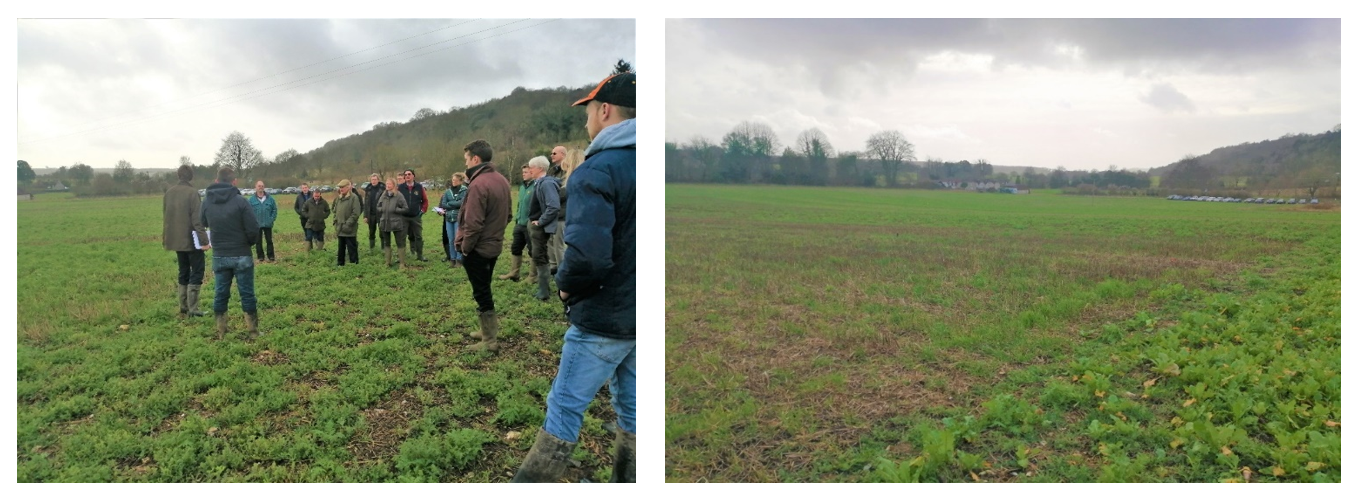
Cover Crops trial Summaries
Lockash Farm
Overview
This study aims to demonstrate the feasibility of growing cover crops ahead of spring cropping as a means of reducing over-winter nitrate leaching losses from the shallow chalk soils found across much of Portsmouth Water’s catchment area. As well as assessing the impact on water quality, the study will also evaluate the effect of cover cropping on subsequent spring crop yields and gross margins in order to demonstrate the impact for the whole farm business. The work is being undertaken on a commercial farm in Hampshire over three cropping seasons (2018-2021), with a new field selected each season according to the host farmer’s crop rotation (i.e. a field that is scheduled for spring barley).
Cover crop treatments and assessments
Three cover crop treatments (Table 1) were drilled in August 2019 along a 100m length of a single ‘tramline’ width (36m) on a shallow silty clay loam soil over chalk (depth to chalk: c. 40cm). The cover crop species were selected to give a ‘simple’ low cost option (oats) compared to a mix that would qualify for an Ecological Focus Area green cover (EFAGC) payment (oats & phacelia), with both options compared to an untreated stubble (which became a weedy stubble during the course of the winter). The cover crops were established using a single pass of the farm ‘Bio Drill’ mounted on a ‘Top Down’ cultivator. This comprised a combination of discs working to 30mm depth, followed by a set of tines working to 120-140mm depth, followed by a set of levelling discs after which the seed was broadcast and finally rolled.

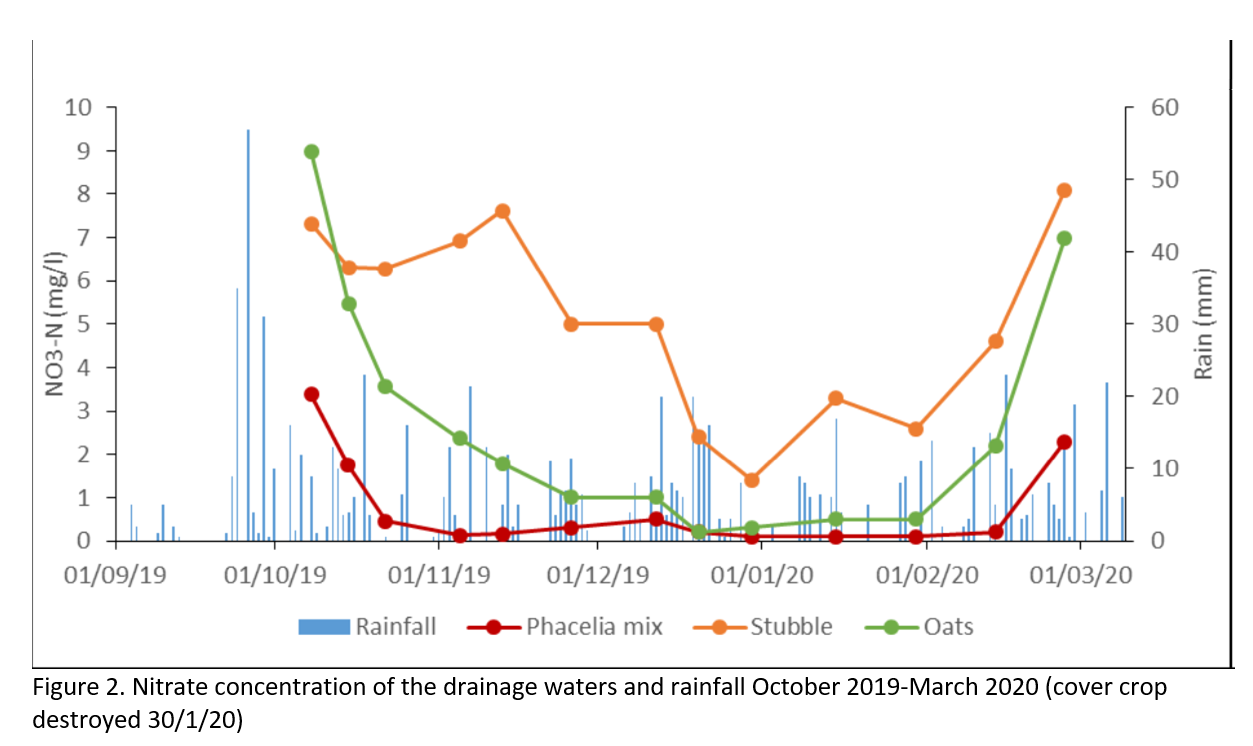
Conclusions – year 2
The residual soil mineral N levels were considerably lower post-harvest ahead of the winter 2019/20 drainage season (< 30kg/ha SMN to 40cm, compared to 80-110 kg/ha SMN to 60cm in 2018). Over-winter nitrate leaching losses were consequently lower than measured the previous year (maximum loss of 25 kg/ha, compared to 60 kg/ha in 2018/19), despite higher rainfall and drainage volumes. However, in both seasons, the phacelia/oat cover crop mix was very effective at reducing nitrate leaching losses to negligible levels (80-90% reduction in N losses across both seasons), with a clear relationship becoming apparent between the percentage crop cover and nitrate loss.
There was also no detrimental effect of growing the cover crop on the yield of the spring barley, but net margins were c. £80-90/ha lower compared to growing no cover crop. The reduced margin reflected the cost of establishing the cover crop, with the differences in soil N supply not sufficient to justify adjusting N fertiliser rates. Applying for the BPS EFA greening payment would have reduced the costs of the phacelia treatment, but this payment will not be available from 2021 due to the transition towards the new ELMS in England.
Chilgrove Farm
Overview
This field trial aims to demonstrate the feasibility of cover crop establishment on shallow chalk soils within Portsmouth Water’s catchment zones, while highlighting the impact they have on over winter nitrate-N loses. The trial will also take into account the impact that cover cropping has on the yield of the following spring cereal and its gross margins.
- Control (bare stubble)
- Broadcast into standing crop (Nitrogen uptake mix)
- Broadcast into standing crop (Farmers choice of seed mix)
- Traditionally Drilled (Nitrogen uptake mix)
Winter 2019-20 results
Treatment 1 (broadcast after harvest) grew well, quickly providing 50% ground cover by the middle of October and progressing on to have 90% ground cover by January 2020 (see picture below). Treatment 2 was originally broadcast into the stubble the same day as treatment 1. Unfortunately, it wasn’t possible to get the plot rolled and the seed showed no signs of germinating. It was decided to re-drill this plot at the same time as plot 3. There was sub 20% cover until November and good establishment levels didn’t happen until January with overall coverage at 70%. Treatment 3 was always going to be drilled, but just like treatment 2, poor weather conditions hindered the cover crops growth with good establishment (80%) not being present until January 2020. The lack of frosts ensured the cover stayed right through until it was sprayed off and worked down in late February 2020.
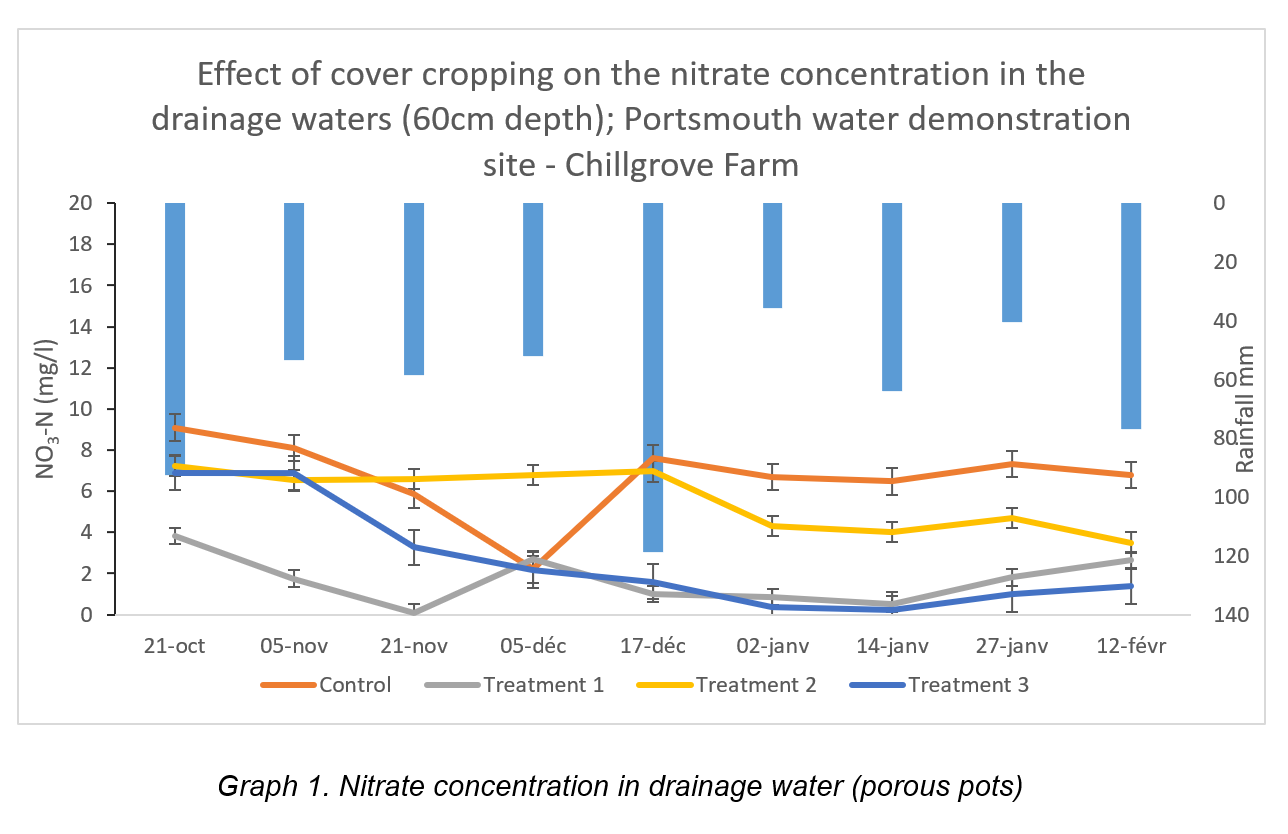
Conclusions
The nitrogen removal mix was very effective at reducing the levels of nitrate washing through the soil profile. On average it was twice as effective as the simple phacelia / vetch mix chosen by the host farm. The excessive rainfall in mid-December was reflected in the sudden jump in nitrate concentrations in the porous pots in the control plot. This correlation is what would be expected. SMN figures where consistently low across all 4 trial plots in the autumn of 2019 and spring 2020. The SMN levels recorded in spring 2020 are not high enough to be taken into account when calculating the following crops nitrogen requirements. The SNS index of 0 is the same as predicted in the RB209.Gross margins and knock on yield effects will be monitored throughout the growing season of 2020 and assessed in October.
Unfortunately it was not possible to determine whether the cover crop plots had any detrimental impact on yield. The reduced margin from planting cover crops does not take into account any support payments that are currently available (e.g. BPS Greening agreement and support payments towards the cost of cover crop seed from Portsmouth Water). The costs quoted demonstrate how much more expensive it is to specifically drill the cover crop seed rather than broadcasting into a standing crop. If cover crops are to be a success they need to be low cost to establish.
Efficient N trial Summary
Scope
The project aims to trial the use of Efficie-N-t 28, a liquid foliar nitrogen fertiliser based on urea polymers of variable lengths. The intention is to run the trial as described below over a minimum of three growing seasons (2019-20, 2020-21, 2021-22).
The use of foliar nitrogen is in principle a very good way to cut total nitrogen applied to fields, reduce the soil applications where most nitrogen is lost and ultimately reduce nitrates leaching into groundwater. The application of nutrients directly to plant tissues is theoretically very efficient (~100%) hence reducing losses to the environment. Although there are many products on the market the fear of yield loss is a major blocker for further uptake.
Field Background:
- Established using a combination drill.
- Variety: Siskin
- Soil Type: Clay loam over gravel
- 24m tramlines
- South facing
Efficie-N-t 28:
Is a liquid foliar nitrogen fertiliser based on urea polymers of variable lengths. The longer the chains, the slower they breakdown, resulting in a phased release of nitrogen over a total of 6 to 8 weeks. The manufacturer claims that the product is:
- Not prone to leaching
- Not prone to volatilisation
- Nearly 100% uptake
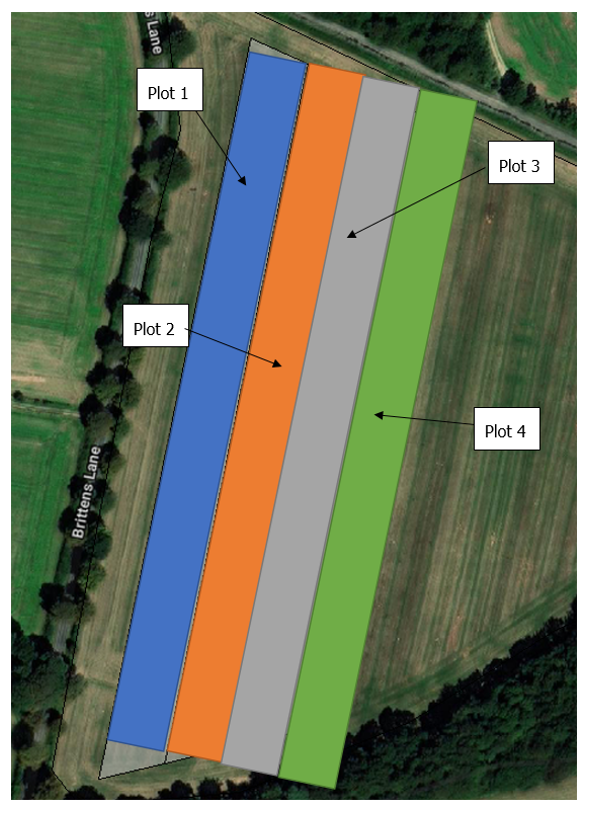


Conclusions so far:
This trial has set out to answer the simple question; does the use of polymer based nitrogen fertiliser improve crop yield and reduce the risk of leaching. We started the growing season after one of the wettest winters on record. As a result, spring SMN figures were very low. 2020 was the third dry year in a row and unlike 2019, we received very little rainfall in May & June (a key period for grain swelling and protein development). As a result yields across the Sussex area have been very mixed with the chalk tending to yield better than the weald clay. Proteins however have been low across the board, with very few wheat crops making milling quality.
The wet winter of 2019-2020 resulted in high levels of nitrate leaching so as expected nitrogen levels coming out of the winter period where low with an average figure of 16.15kgN/ha. But despite the challenging growing season, nitrogen left in the soil after harvest is nearly the same at 20kgN/ha.
Plot 4 (control) was the best performing plot in terms of yield and financial return. But plot 3 (20l E28 @ T3) was the best performing plot in terms of protein and with only a yield drop of 0.1t/ha and a reduced N application of 33kg/ha, it is far more efficient.
The trial demonstrates that the crop yield does not drastically drop by using E28 at T3, but it does show the limitations of polymer based nitrogen products. There is a limit on how much N can be absorbed through the leaf and plots 1 and 2 show this. The plat simply did not get enough nitrogen into the grain.
The trials work is not being carried out under exact scientific conditions and there are many variables that cannot be controlled. For this reason the results should be interpreted with the understanding that they may not be 100% accurate or representative. However, the results certainly lend themselves for further investigation to try and further understand how the use of polymer based nitrogen fertiliser can help create a balance between meeting the farms needs in terms of yield and aid Portsmouth Waters to meet targets in reducing nitrates going into our water supplies.
Nitrate Reduction trial Summary
Scope
As with most farming decisions, economics tend to be the deciding factor on most farms. Getting the balance between input levels and potential outputs (yield) without knowing what the current season is going to produce in terms of climate has always been difficult. With ever increasing pressure to improve our environmental footprint, it asks the question are we applying too much nitrogen fertiliser. Does the improvement in yield offset the environmental impact of over applying nitrogen fertiliser?
Trial Aim
This trial aims at improving our understanding and measure the impact reduced nitrogen applications can have on yield, protein in the grain, residual nitrogen levels in the soil and the economic impacts on the grower. A 5ha field currently planted with wheat will be split into 5 separate sections (excluding any headland) to compare the crop and soils response to different nitrogen applications and timings.
- Control (farmers historic N application)
- 5% reduction total N
- 10% reduction total N
- 15% reduction total N
- 20% reduction total N
Field Background:
- Chalk Loam soil
- Field is south facing in a valley bottom
- Variety: (Skyfall)
- Established using a combination drill
- 24m tramlines
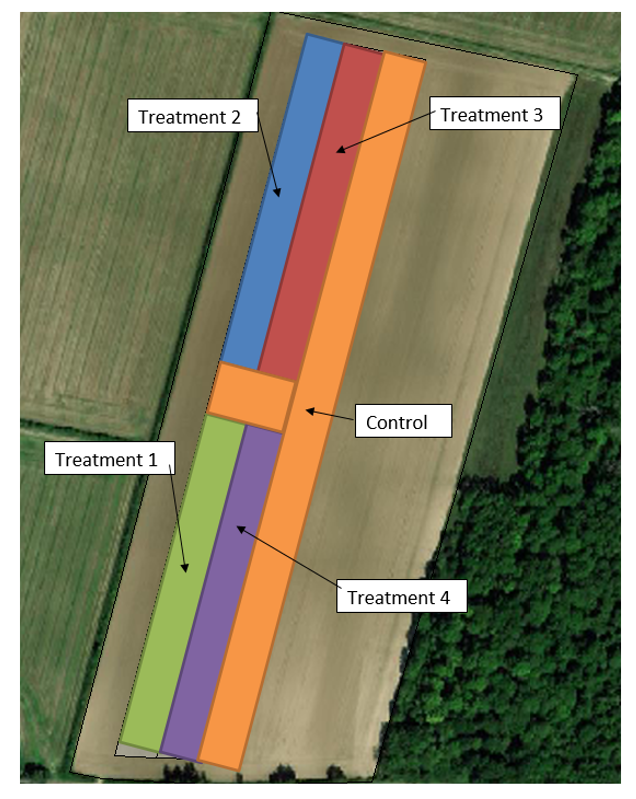
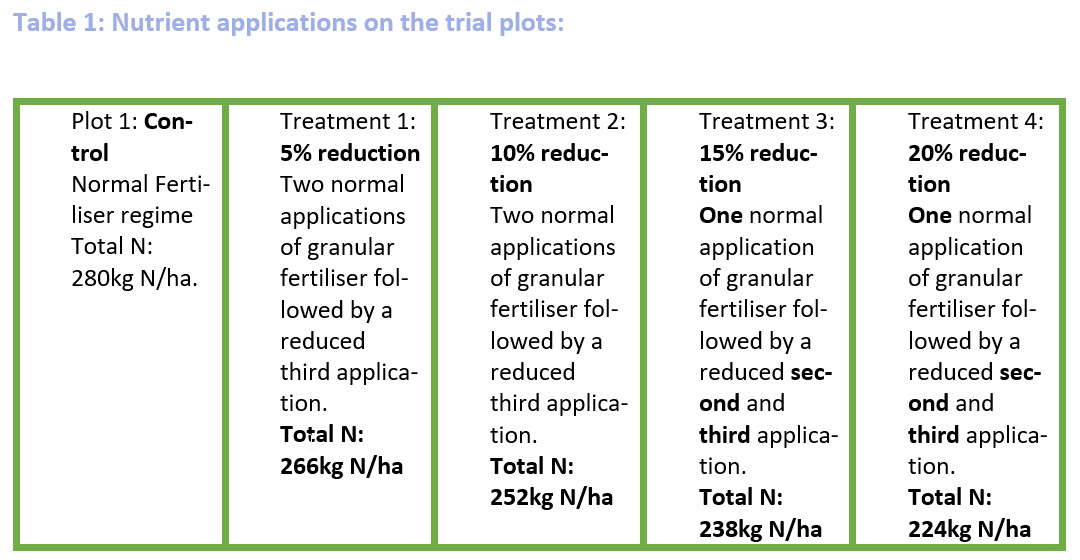
Conclusions so far
This trial has set out to answer the simple question; are farmers applying the correct amount of nitrogen to meet their needs (in terms of yield and economic return)? 2020 was the third dry year in a row and unlike 2019, we received very little rainfall in May & June (a key period for grain swelling and protein development). As a result yields across the Sussex area have been very mixed with the chalk tending to yield better than the weald clay. Proteins however have been low across the board, with very few wheat crops making milling quality.
The wet winter of 2019-2020 resulted in high levels of nitrate leaching so as expected nitrogen levels coming out of the winter period were low with an average figure of 27.5kgN/ha. But despite the challenging growing season, nitrogen left in the soil after harvest is nearly the same at 28kgN/ha. This indicates that the crop demand was met by the nitrogen applied.
Treatment 2 (10% reduc) was the best performing plot in terms of yield and economic return. It also performed strongly in terms of the autumn SMN being near enough the same as the spring SMN. However in terms of the most efficient plot, treatment 4 (20% reduc) has come out on top with only 17.8kgN per 1 ton of wheat.
The results from this year’s trail demonstrate that reducing n applications does not necessarily led to that dreaded yield drop. It is fair to say that a 20% reduction in N did led to a £67/ha loss to the grower, but is this the area where water companies can provide a top up payment? Would a 20% reduction in N correct the upward trend of nitrates within the soil?
It isn’t possible to draw any concrete conclusions from this trial so far as it needs to be treated as a one year snap shot. However, the results certainly lend themselves for further investigation to question whether farmers are applying the right amount of N for their crops or not. Is there a balance between meeting the farms needs in terms of yield and while hitting Portsmouth Waters targets in reducing nitrates going into our water supplies.
Eartham Mob Grazing Trial 2020-21
Aim
This field trial sets out to understand and measure the benefits of a mob grazing system and how it can move farms away from being so reliant on manufactured inputs. There are many publications out there that talk about the benefits of a mob grazing system and how it can move farms away from being so reliant on manufactured inputs. This field trial aims to understand the feasibility and effectiveness of Mob grazing within a mixed farming system in terms of fertiliser inputs (Nitrogen, P, K & Mg), animal weight gain per hectare, cash crop yield and labour requirements.
Field and Farm Choice
Portsmouth Water and S. Woodley Crop Services are working alongside R & S Payton of Home Farm Eartham to host the trial. They operate a mixed farming system rotating grass throughout the arable rotation. Traditional cultivation methods are utilised and FYM is incorporated where deemed beneficial. The soil type of the trial field is silty clay loam over a bed of gravel, making the ground extremely free draining and vulnerable to a drought year such as 2020.
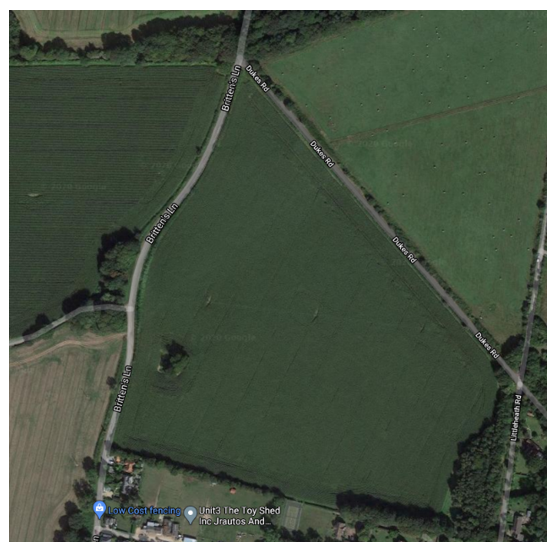
Field Assessments
- Soil health and nitrate assessment of the host field pre grass.
- SMN sampling each spring and autumn in three zones across the field each year. (Two bands 0-30cm & 30-60cm)
- Annual consultancy with an animal nutrition specialist to assess the sheep performance.
Results from 2020
Brittens Lane Field was in winter wheat for the 2019-20 cropping year. Prior to the field being planted with the herbage ley (see figure below), it was soil sampled to understand the residual nitrogen within the soil as well as current health of the soil (nutrients, OM, bacteria levels etc).
- P – Index 3, K – Index 2-, Mg – Index 1
- OM 6.2%
- Bacteria respiration levels: 186mg Co2/kg.
- Seed mix: The grass seed took well given the mild wet autumn we experienced. The field was setup up appropriately and fenced into 10 individual hectare sections and grazed over the course of 10 days (24hrs per section). Pasture recovery has been excellent and it is expected to be re grazed by the end of January.
A full update including grower testimonials will be produced Spring 2021.


